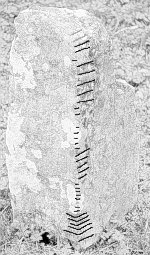Location and history:
For the location and discovery, cf. {148}. According to Ferguson, OI 43, this stone "occupied the summit of the knoll". Ferguson saw it in "Lough, near Ballintaggart" in 1870; Brash "found" it (in 1868?) "at Lough House, .. the residence of the Rev. Richard Chute", where he "recognized it from a copy of the inscription made by Mr. Windele, in 1838, when the stone was still in situ" (OIM, 210).
Size according to Brash, OIM 210: 3'2" x 10" x 9"
Size according to Macalister, CIIC: 3'0" x 0'9" x 0'10"
Size according to DPAS, no. 792 (4), p. 251: 1.82m x .26m x .25m
Published illustrations:
- Macalister, CIIC I, 147 (draft)
Reading Brash, OIM 210 (no. 4):
ᚁᚏᚑᚔᚅᚔᚑᚅᚐᚄ
BROINIONAS
"The name appears to be Broinion, in a genitive form"; cp. "Brian, one of the triumvirate sons of the Tuatha-de-Danaan Dealbaoth, or .. Tuireann Bierind" from the Book of Lecain. Further cp. "Bron, the son of Alloit, and brother of Mananann Mac Lir, from whom Moy Bron in Tyrawly derives its name .. Bronn, a bishop, A.D. 511, Bronach, son of Bolar, A.D. 512. Dr. Ferguson hints Brendan, but this is too foreign."
BROINIUNAS
Broiniunas
"The as genitive instead of the ias of other examples may invite the attention of the grammarian. Broinion, as a proper name, seems to import, like Corb, personal depreciation." Ferguson adds a list of names as established by Edmond Le Blant (in Revue Archæologique, N.S. x. 5) which witness to "self-depreciation and reproach assumed by Christian devotees from the fourth to the eighth century".
ᚁᚏᚑᚔᚅᚔᚑᚅᚐᚄ
BROINIONAS
This is "the genitive of an n-stem name Broinio also found at Monataggart, Co. Cork {120}"; there we find the spelling Broinienas, "in which Professor Rhŷs traces Pictish influence."
BROINIONAS
"The top of the stone is broken, but there is nothing to suggest that there was ever any continuation of the writing."
BROINIONAS
The inscription is preserved complete.
BROINIONAS
Reading DPAS, no. 792 (4), p. 251 (and OSDP, 8):
BROINIONAS
Reading Gippert (1978/1998):
 Angle up:
Angle up:
BROINIONA(S)
ᚁᚏᚑᚔᚅᚔᚑᚅᚐ(ᚄ)
ᚁᚋᚋᚋᚋᚋᚐᚐᚐᚐᚐᚐᚐᚁᚁᚁᚁᚁᚐᚐᚐᚐᚐᚐᚐᚁᚁᚁᚁᚁᚐᚁᚁ(ᚁᚁ)
The last two scores of the final S are faint.
Additional literature:
- Revue Archæologique, N.S. x. 5: E. Le Blant.
 Angle up:
Angle up: